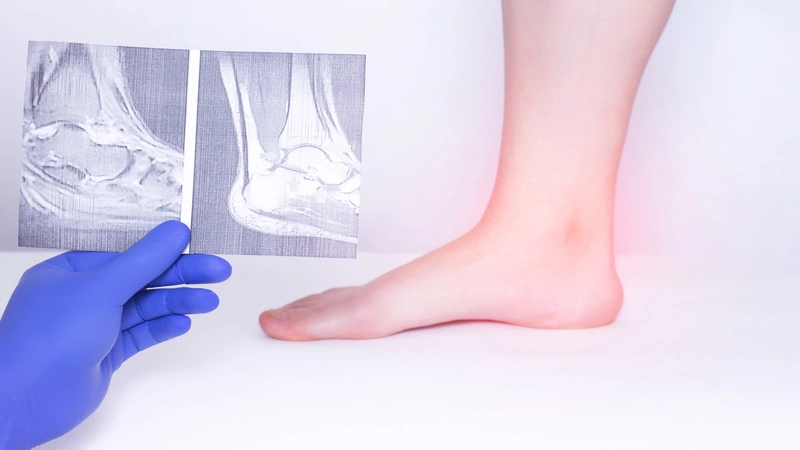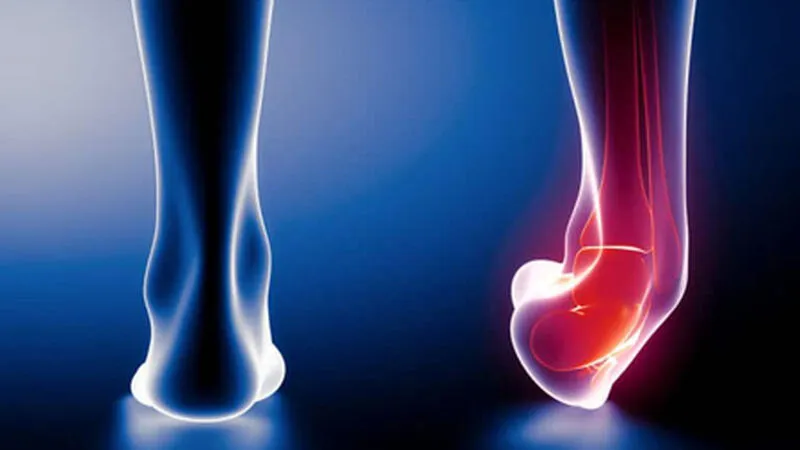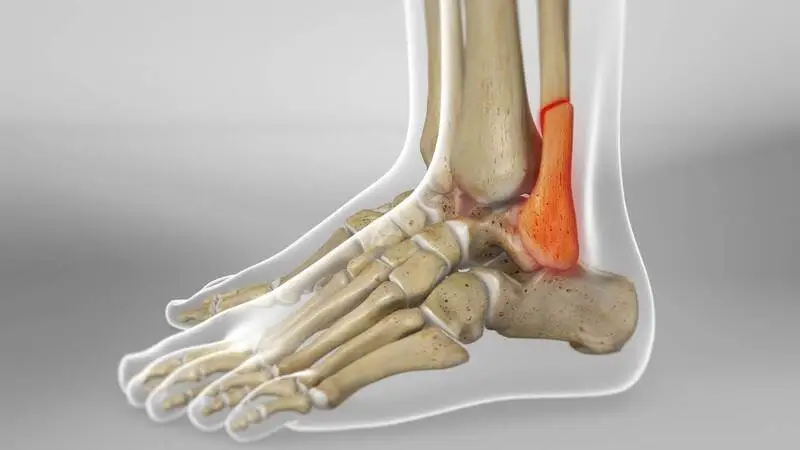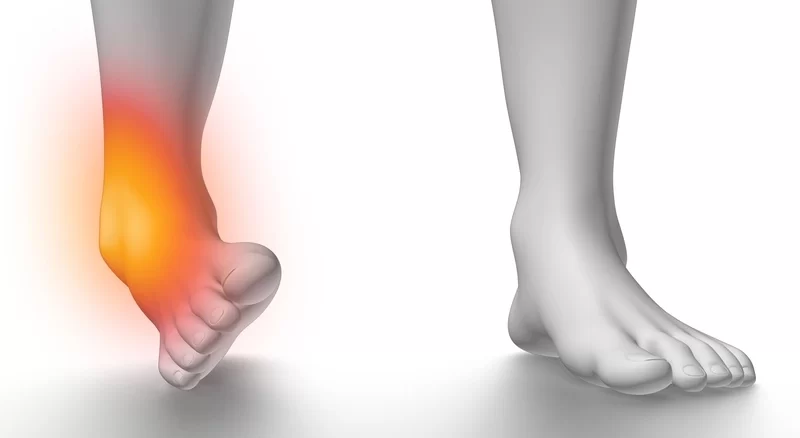Statistics show that every day 10,000 people suffer from ankle instability and sprains. An injury that stretches and tears one or two of the main ligaments of the outer part of the wrist.
Ankle instability is one of the most common treatable musculoskeletal diseases. The incidence of this disease in the general society is 2.15 per 1000 people. While most patients recover without long-term complications, some may develop instability and chronic ankle sprains. In the following, we mention all the points you should know about ankle instability.
What is ankle instability?

On the outside and back of your ankle, two peroneal tendons connect the muscles of this area and allow you to stand on your toes. When one of these tendons or both is moved and comes out of the groove that is always inside, it is said that this tendon is unstable.
However, semi-dislocation is an injury similar to dislocation, but less severe, during which one or both peroneal tendons slide inward or outward and come out of their natural position. Tendons are usually held in place by a ligament-like structure called the retinaculum. But the damage to this supporting structure will increase the incidence of dislocation and semi-dislocation of tendons. When faced with this problem, you should immediately go through the treatment of ankle Instability in Dubai since this city has the best doctors for treating your disease.
✔️ Read More: Bunion Deformity: Everything You Need To Know About It!
Why does ankle instability occur?

A strong force causes dislocation and semi-dislocation of peroneal tendons on these tendons; this force must be strong enough to dislodge one or both of these tendons. The most common mechanisms of this damage are:
A sudden and severe impact, such as bending with a sudden and high force on the ankle (often causing the foot to twist outwards), which overcomes the resistance force of the peroneal muscles.
Severe twisting of the ankle that you have since birth (congenital defect). For example, the tendon’s groove is congenitally shallow or malformed.
What factors increase the risk of ankle instability?

- Skiing on the snow or skating on the ice
- Playing sports that require jumping (such as basketball, gymnastics, and volleyball)
- Playing games where turning on the heel is very important (such as football and lacrosse)
- Sports and playing on uneven fields and uneven surfaces
- Having a history of foot or ankle injury
- Lower body strength and flexibility
If the dislocation and semi-dislocation of the peroneal tendon are treated properly, it can be expected to recover completely.
✔️ Read More: Ankle Arthritis; From Diagnosis to Treatment
What are the side effects of ankle instability?

- Chronic pain and disability and frequent dislocation of the tendon
- Tendon rupture due to its frequent dislocation and semi-dislocation
- Instability and arthrosis of the ankle joint due to frequent injury or postponing the treatment of heel.
Symptoms of ankle instability

- Hearing or feeling the sound of “thump” at the time of leg injury
- Pain, swelling, redness, and dead blood (bruising) at the injury site on the back and outside of the ankle, which is aggravated at the beginning of the injury when standing or walking.
- Pain and weakness when you try to move your leg to the affected side.
- A “popping” sound when you touch or shake the tendon.
- Numbness or numbness of the lower parts of the dislocation site due to beating, cutting, or compression of nerves or blood vessels (which, of course, is not a common symptom of this condition).
Often, it does not cause any symptoms or problems while walking, but when you want to change direction or turn on the heel of the injured foot and move towards the injured side, you feel the symptoms and discomfort caused by the condition.
How does a doctor diagnose ankle instability?

A physiotherapist can treat the injury and instability of the patient’s ankle by evaluating and performing movements on the ankle and using x-rays to detect the inclination of the ankle. In the ankles of healthy people, this inclination is about 5 degrees, and in people who suffer from ankle instability, this inclination increases by 15 to 20 degrees, which is clearly visible in X-ray imaging. In the following, we discuss the types of treatment for ankle instability.
✔️ Read More: What is the Sesamoid Bone? How to Treat it?
Treatment of ankle instability

The treatment of ankle instability begins with a series of strength exercises for the external muscles of the ankle and continues with efforts to compensate for the lost ligaments. While this treatment is effective for most people, it is less effective for people with strong joints, such as dancers or other athletes.
If the patient initially has instability in his ankle while performing activities, he should use a strap or splint either in his shoes or around his ankle. Although this treatment is not enough to eliminate the instability of the ankle to perform daily activities, the doctor suggests cosmetic foot surgery to treat the instability. However, you can also go through a foot surgeon in Dubai to get the best results.
The best methods for treatment
- The Rest, Ice, Compression, and Elevation (R.I.C.E.) method should be applied to all injured persons who have suffered a dislocation or semi-dislocation of the tendon.
- Physical therapy, including heating and cooling or ultrasound, can be used to reduce swelling and pain.
- After the inflammation of the affected area subsides, gentle stretching movements should be performed.
- Sports massage techniques have a very favorable effect on releasing the pressure on the peroneal muscle due to dislocation or semi-dislocation of the tendon.
- For faster recovery of the peroneal tendon after dislocation or semi-dislocation, the leg can be cast for three to four weeks.
- Injured people who suffered dislocation or semi-dislocation of the peroneal tendon should participate in a rehabilitation program.
- Surgery for peroneal tendon dislocation is very rare and only necessary if the damage to the tissue that holds the tendon in place is so severe that it cannot be repaired.
- Suppose surgery is performed for dislocation or semi-dislocation of the peroneal tendon. In that case, strengthening and balance exercises must be performed after the operation to restore the optimal function of the ankle.
- Cooling (putting ice) on the injured area reduces pain and inflammation. Ice should be placed on the ankle every 2 to 3 hours and immediately after activities that aggravate the injury symptoms.
✔️ Read More: Why Does the Knee Make Noise? Is the Knee Noise Dangerous?
Sports exercises
In addition to the above treatment methods, you can treat ankle instability by doing sports. These exercises include the following.
Exercises to improve range of motion and stretch
These exercises can help improve your condition when you have a new injury or are rehabilitating. The injury symptoms can be relieved by performing these exercises even without the intervention of a doctor, physiotherapist, or sports coach. As you do these exercises, keep in mind that:
- Restoring the tissue’s flexibility will help restore the joint’s ability to move normally. This way, your movement, and activity will be done healthier and with less pain.
- Stretching movements should be held for at least 30 seconds.
- Stretching should not be painful; you should only feel a gentle stretch or release of pressure in the affected tissue.
Turning the ankle outward
- Sit on a chair, lift the injured leg’s ankle, and place it on the knee of the other leg.
- Hold your foot with the opposite hand, so that the thumb is on the foot and the other four fingers are on the sole.
- Gently push your foot down and, at the same time, rotate very slightly so that your little toe rises slightly.
- By doing this movement, you should feel a gentle stretch on the inside of your ankle.
Turning the ankle inwards
- Sit on a chair, lift the injured leg’s ankle, and place it on the knee of the other leg.
- Hold your foot with the opposite hand so that the thumb is on the sole of the foot and the other four fingers are on foot.
- Lift your foot slowly, so your smallest toe is close to your body, and push your sole outward with your thumb.
- By doing this movement, you should feel a gentle stretch on the outside of your ankle.
Ankle flexion
- Sit on a chair, lift the injured leg’s ankle, and place it on the knee of the other leg.
- Using the opposite hand, pull the top of the foot and the toes towards you.
- Doing this movement, you should feel a gentle stretch on your foot and ankle.
✔️ Read More: What Is Blunt’s Disease? Symptoms and Treatment Methods
Stretching of the gastrocnemius muscle in the standing position
- Put your hands on the wall.
- Put the injured leg back, pull it, put the opposite leg in front, and bend it a little.
- Put your rear toe slightly inward.
- While keeping the sole of your back foot on the ground and keeping your knee straight, throw your body weight forward towards the wall and don’t let your back bend.
- You should feel a gentle stretch in the leg by performing this movement.
Stretching the soleus muscle of the leg in a standing position
- Put your hands on the wall.
- Put the injured leg back, pull it, put the opposite leg in front, and bend it a little.
- Put your rear toe slightly inward.
- While keeping the sole of your foot on the ground, slightly bend the knee of your back leg and slowly shift your body weight onto the back leg so that you feel a gentle stretch deep in your back leg.
Strengthening exercise – rolling the towel
- Place your chair on a non-carpeted surface and sit on it.
- Place your foot on a towel while keeping the heel on the ground.
- Just by moving your toe, pull the towel towards the heel. Make sure that the heel does not leave the ground.
✔️ Read More: What Is a Heel Spur? The Cause of the Disease and Its Treatment Methods
How to prevent ankle instability?
- Before sports activities, warm up your body well and do stretching exercises.
- Keep fit
- Protect your injured ankle with supportive and protective equipment such as elastic bandages, tape, braces, and high-leg sports shoes.
- Avoid running and doing other sports activities on uneven surfaces.
- After an ankle injury, be sure to go through a full rehabilitation period before returning to sports and games.
Surgical treatment
Surgery on ankle instability is divided into two groups.
Automatic rehabilitation or reconstruction of the ankle
In this surgery, the torn and stretched ligaments are restored in a short position. In fact, the doctor uses the patient’s tissues for resuscitation, called Brostrom surgery. Carcass tendons or allografts are used if the patient’s tendons are stretched and different. For this stability and prevention of re-injury of the retina, the retinaculum or fibrous bands narrow the tissues to help maintain the wrist Padron ligaments.
In most cases, automatic resuscitation is possible and preferable to other surgeries. This surgery’s advantages usually include full joint movement, minimal injury, and a quick recovery period. One of the weak points of this surgery is that the ligaments may be destroyed and need to be repaired again, but this rarely happens. The results obtained from Broström surgery show that this surgery worked very well.
About 73% of the patients who performed this surgery were completely satisfied with the result of the operation, and maybe only one of them needed a repeat operation. The automatic tissue reconstruction surgery is not successful in all cases because of the use of the patient’s tissues, like people whose tissues are damaged and unsuitable for repair. When the torn ligaments have suffered a lot of damage, the doctor uses the allograft tendon.
✔️ Read More: Electromyography; Definition and Benefits
Replacement surgery
This surgery includes replacing the person’s ligaments and restoring ligaments. In this surgery, the ligaments are completely replaced with the patient’s ankle tendon. In fact, a surgery that uses the person’s own tendon is less likely to stabilize the ankle.
A larger gap is needed in surgery to replace one’s ligaments than in automatic tissue reconstruction surgery. Its recovery period is longer, and the risk of nerve damage and chronic pain is one of the disadvantages of this surgery. Doctors rarely use surgery to replace ligaments because of the destruction of the useful tendons of the body and the post-operative period is very painful and difficult.
In all these surgeries, epidural anesthesia is used for the treatment of ankle laxity, anesthesia that is used for women during childbirth. However, very sensitive people can stay awake during surgery and use local anesthesia. Hospitalization of these patients after surgery is not very necessary.
After both of these surgeries, good results are obtained and the patient recovers for a long time, and the arthritis disease disappears from the body. Instability of the knees does not cause arthritis. When the bones are pulled against each other and wear, it causes aging and instability of the joint. After that, it destroys cartilages and causes arthritis in the joints.
✔️ Read More: What Is Physiotherapy? Benefits and Applications
Procedures after surgery
The patient should use a splint to protect the leg or a stick or cane when walking to avoid putting pressure on the ankle. After two weeks, the splint is removed, and a cast is placed around the ankle and placed on the ankle for 2 to 4 weeks. Physiotherapy exercises are performed six weeks after the ankle protection is put on for walking, and these exercises continue for 12 weeks.
After 10 to 13 weeks, most patients do not need to use a splint to perform their daily activities and can continue their activities normally and even participate in sports activities. Orthopedic surgeons also treat patients who need re-surgery after automatic tissue reconstruction because the ligaments of these patients have been destroyed due to pregnancy, and the patient needs re-surgery.
In these cases, replacing the tendon is suggested. People who have performed ankle ligament reconstruction surgery and have experienced leg nerve damage and hardening are looking for other surgeries to treat the ankle. This condition is very difficult and must be performed by a specialist and experienced surgeon.
Who is at risk of ankle instability?
The following factors increase the risk of developing an ankle sprain:
- You do heavy sports activities
- If you have sprained, broken, or sprained your ankle in the past
- Your ankle has been abnormal since birth
- If you smoke or are overweight




